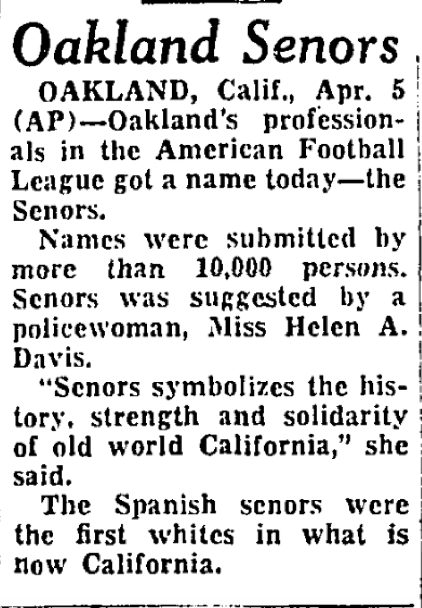Happy Independence Day, folks. July 4th, 1776 was the day our forefathers declared independence in a remarkable document that’s worth your full read. We at Football Perspective wish you a very happy, and very safe, Fourth of July.
153 years after America declared its independence, Al Davis was born. On January 30th, 1960, the AFL awarded Oakland the last franchise for the new league. Then, in early April, the team was named:
A few days later, the name was changed to Raiders, a couple of years later, Davis was brought in, and the franchise is now forever associated with one of football’s giants.
Oakland has fallen on hard times in recent years, but the Raiders made significant strides in 2015. The graph below shows Oakland’s points differential in every year in franchise history:

As you can see, 2015 — which followed the 2nd worst season in Raiders history — was a year of significant improvement for Oakland. It’s one of just 8 times the Raiders have improved their points differential by 100+ points year over year. The graph below shows the same information, but also includes (in a light silver line) the improvement in points differential for each year:

The Raiders made a big improvement from ’81 to ’82, and then won a Super Bowl in ’83.
Oakland made a big improvement from ’66 to ’67, and made the Super Bowl that year.
The Raiders made big jumps in both ’99 and ’00, setting up the 2002 Super Bowl run.
In ’63 and ’65, the Raiders made big jumps as Davis gained control, setting up the franchise for two decades of sustained success.
Does that mean these modern Raiders are on a Super Bowl trajectory? Well, there is one outlier year to deal with: 2010. The Raiders were terrible in 2009, with JaMarcus Russell at quarterback, but turned things around in ’10. That Raiders team was led by Jason Campbell and was incredibly young at the skill positions: the leaders in yards from scrimmage were Zach Miller (25), Louis Murphy (23), Darren McFadden (23), Jacoby Ford (23), Darrius Heyward-Bey (23), and Marcel Reece (25). Oakland looked to be rising, but McFadden and DHB never delivered on their first round promise, and Campbell’s broken collarbone the next year wound up costing the team dearly: not only did the Raiders lose Campbell, but the Carson Palmer trade to replace him wound up costing Oakland first and second round picks.
Oakland’s first round pick in 2010, Rolando McClain, was a bust with the Raiders, and Oakland was without a first round pick in ’11 (Richard Seymour trade) or ’12 (Palmer). As a result, the Raiders wound up regressing and spiraling back to being one of the league’s worst teams. But there was a moment when Oakland seemed on the verge of capitalizing on the improvement from 2010: that moment, according to the Elo ratings, was in week 6 of the 2011 season, when the Raiders were finally a team that was clearly above-average:

That game against the Browns, of course, was the one where Campbell broke his collarbone. From that moment until about October 2015, there wasn’t much to smile about for the Raiders. But given the big strides made by Oakland last year, the 9th youngest offense in the NFL in 2015 (led by Derek Carr and Amari Cooper), and the strong offseason had by the team (the Raiders added Kelechi Osemele, Sean Smith, and Reggie Nelson in free agency), things are finally looking up again for the Silver and Black.

